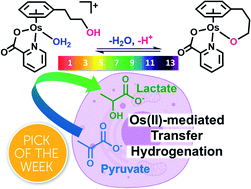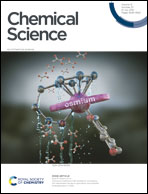Osmium(ii) tethered half-sandwich complexes: pH-dependent aqueous speciation and transfer hydrogenation in cells†
Abstract
Aquation is often acknowledged as a necessary step for metallodrug activity inside the cell. Hemilabile ligands can be used for reversible metallodrug activation. We report a new family of osmium(II) arene complexes of formula [Os(η6-C6H5(CH2)3OH)(XY)Cl]+/0 (1–13) bearing the hemilabile η6-bound arene 3-phenylpropanol, where XY is a neutral N,N or an anionic N,O− bidentate chelating ligand. Os–Cl bond cleavage in water leads to the formation of the hydroxido/aqua adduct, Os–OH(H). In spite of being considered inert, the hydroxido adduct unexpectedly triggers rapid tether ring formation by attachment of the pendant alcohol–oxygen to the osmium centre, resulting in the alkoxy tethered complex [Os(η6-arene-O-κ1)(XY)]n+. Complexes 1C–13C of formula [Os(η6:κ1-C6H5(CH2)3OH/O)(XY)]+ are fully characterised, including the X-ray structure of cation 3C. Tether-ring formation is reversible and pH dependent. Osmium complexes bearing picolinate N,O-chelates (9–12) catalyse the hydrogenation of pyruvate to lactate. Intracellular lactate production upon co-incubation of complex 11 (XY = 4-Me-picolinate) with formate has been quantified inside MDA-MB-231 and MCF7 breast cancer cells. The tether Os–arene complexes presented here can be exploited for the intracellular conversion of metabolites that are essential in the intricate metabolism of the cancer cell.

- This article is part of the themed collections: 2021 ChemSci Pick of the Week Collection, 2021 Chemical Science HOT Article Collection and Most popular 2021 main group, inorganic and organometallic chemistry articles, 2021


 Please wait while we load your content...
Please wait while we load your content...